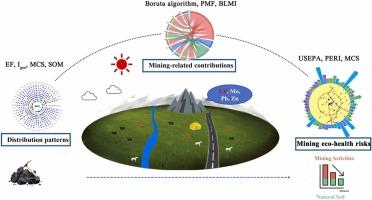长期开采道路粉尘中潜在有毒元素的空间生态健康影响——以白云鄂博矿区为例
IF 11.3
1区 环境科学与生态学
Q1 ENGINEERING, ENVIRONMENTAL
引用次数: 0
摘要
巴彦鄂博矿区采矿活动对道路粉尘中潜在有毒元素(pte)的长期影响仍未得到充分了解。本研究旨在通过研究采矿产生的大块道路粉尘(BRD)和重悬浮道路粉尘(RRD)中pte的空间和生态健康影响来丰富这一领域的知识。采用蒙特卡罗模拟与多种统计和地质统计方法相结合的综合方法对采矿相关影响进行了量化。结果表明,镉是污染最严重的元素。Cd、Mo、Pb和Zn的浓度在矿区附近显著升高,随距离的增加而降低,开采活动对这些pte的直接贡献超过20%。BRD和RRD分别存在中度和相当大的生态风险,主要由Cd和Mo驱动,靠近矿山的风险更高。虽然非致癌风险可以忽略不计,但成人的致癌风险需要引起注意。与采矿有关的来源占生态风险的30%以上,但不到健康风险的10%。该研究整合了多种方法,为采矿活动对道路粉尘中pte的空间和生态健康影响提供了更全面的认识。这些发现为管理其他矿区类似的环境挑战提供了重要的见解和指导。本文章由计算机程序翻译,如有差异,请以英文原文为准。

Spatial and ecological health impacts of potentially toxic elements in road dust from long-term mining activities: A case study of the Bayan Obo deposit
The long-term impacts of mining activities at the Bayan Obo deposit on potentially toxic elements (PTEs) in road dust remain insufficiently understood. This study aims to enrich knowledge in this area by investigating the spatial and eco-health impacts of PTEs in both bulk road dust (BRD) and resuspended road dust (RRD) from mining. An integrated approach combining Monte Carlo simulations with multiple statistical and geostatistical methods was used to quantify mining-related impacts. The findings revealed that Cd was the most polluted element. Concentrations of Cd, Mo, Pb and Zn were notably higher near the mine and decreased with increasing distance, with mining activities directly contributing over 20 % to these PTEs. Moderate and considerable eco-risks were identified for BRD and RRD, respectively, primarily driven by Cd and Mo, with higher risks closer to the mine. While non-carcinogenic risks were negligible, carcinogenic risks for adults required attention. Mining-related sources accounted for over 30 % of eco-risks but less than 10 % of health risks. This research integrates multiple methods, providing a more comprehensive understanding of the spatial and eco-health impacts of mining activities on PTEs in road dust. These findings offer critical insights and guidance for managing similar environmental challenges in other mining regions.
求助全文
通过发布文献求助,成功后即可免费获取论文全文。
去求助
来源期刊

Journal of Hazardous Materials
工程技术-工程:环境
CiteScore
25.40
自引率
5.90%
发文量
3059
审稿时长
58 days
期刊介绍:
The Journal of Hazardous Materials serves as a global platform for promoting cutting-edge research in the field of Environmental Science and Engineering. Our publication features a wide range of articles, including full-length research papers, review articles, and perspectives, with the aim of enhancing our understanding of the dangers and risks associated with various materials concerning public health and the environment. It is important to note that the term "environmental contaminants" refers specifically to substances that pose hazardous effects through contamination, while excluding those that do not have such impacts on the environment or human health. Moreover, we emphasize the distinction between wastes and hazardous materials in order to provide further clarity on the scope of the journal. We have a keen interest in exploring specific compounds and microbial agents that have adverse effects on the environment.
 求助内容:
求助内容: 应助结果提醒方式:
应助结果提醒方式:


